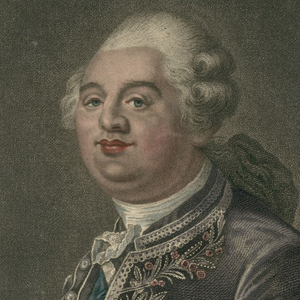Louis the Sixteenth, King of France and of Navarre

Annotation
This portrait demonstrates Louis at the height of his power and authority on the eve of the French Revolution.
Bossuet, "The Nature and Properties of Royal Authority"

Annotation
Jacques–Benigne Bossuet (1627—1704), bishop of Meaux, was a well–known seventeenth–century peacher who believed that although France had a sizable minority of Protestants, France should have a single religion, Catholicism. At the same time, he was a Gallican, meaning he argued that the French clergy owed primary allegiance to the king rather than the Pope in Rome. His emphasis on religious unity and devotion to the French crown—rather than tolerance—appealed to Louis XIV, who appointed Bossuet tutor to heir, the "Dauphin" or crown prince. In this capacity, Bossuet wrote the following passage setting out the basic ideas of the French monarchy.
Moreau, "Principles of Monarchy" (1773)

Annotation
Jacob–Nicolas Moreau wrote his "lessons of morality, politics and law" for the instruction of the Dauphin. Throughout the 200–page book, Moreau defends the power of the King to rule France without opposition. In this passage, he emphasized that the current King must be actively involved in governing and could no longer inspire respect from his subjects merely by occupying the throne, as had monarchs in earlier times. Furthermore, Moreau wrote, only an active King could defend order and thus preserve the liberty of his people.
The Coronation of Louis XVI from the Gazette of France (1775)

Annotation
These two articles from the official newspaper of the day describe the coronation of Louis XVI at Reims, the city to which French kings had traveled to be anointed and crowned for a thousand years. Note the seriousness with which all the King's movements are described and how solemnly this ritual was taken—even though it no longer held its original meaning—demonstrating the consent of all three orders of French society to be ruled by their new King. Actually, the new King had already begun to govern France ten months earlier, upon the death of his predecessor.
The "Session of the Scourging" (3 March 1766)

Annotation
The twelve highest royal courts, known as parlements, not only heard civil and criminal suits; they also had the responsibility of discussing and registering royal edicts before their enactment. Consequently, the parlementary magistrates could, when they saw fit, prevent the King from ruling; by the same token, the King could exercise a sort of reverse veto by forcing the parlements to register his edicts. He did this by convoking the judges of the parlements to a special ceremony known as a "seat of justice." Ordinary appearances by the King before the Parlement of Paris were known as "sessions." At this session in 1766, during the "Brittany Affair" (see Chapter 3 introduction), Louis XV verbally "lashed out" at the magistrates for asserting that they were linked to the Parlement of Rennes and all the other regional courts in a "union." In the King’s view, the idea of such a "union" interfered with his ability to rule over the French people.
Lamoignon, "The Principles of the French Monarchy" (1787)

Annotation
On 19 November 1787, the King convoked the Parlement of Paris to enforce registration of an edict allowing the indebted royal treasury to borrow an additional 420 million livres. When the King appeared before the magistrates, his Keeper of the Seals, Chrétien–François de Lamoignon spoke for him. Lamoignon did not explain what the additional money would be spent on but instead argued that the King’s will had to be obeyed if France was to prosper, thus staking the monarchy’s legitimacy on the acceptance of this single bond issue.
"Letter from a Gentleman in Paris to His Friend in London" (1757)

Annotation
The news of Robert–François Damiens’s attack on the King and his subsequent trial spread rapidly and generated great interest across France and all of Europe. This pamphlet, published in London, describes for English readers the goings–on in Paris, especially the public outpouring of sympathy for the King and the general hostility toward Damiens. Damiens, even for this English observer, was horrible for having dared to touch, let alone try to kill the King—God’s anointed representative in France and the guarantor of public order and domestic peace.
Letter from a Patriot Claiming to Prove Damiens Had Accomplices

Annotation
This pamphlet was one of the many published in France in response to the news of Damiens’s attack on the King. It is written from the standpoint of the so–called patriot party, which opposed the concentration of power in the hands of the King, the royal advisers at court (mostly aristocrats), and the bishops of the church (mostly Jesuits). Patriots instead supported the parlements and the lower clergy as more morally suited to represent the interests of all three orders that composed the French "nation."
Damiens’s Testimony to Parlement

Annotation
During the course of his trial Damiens was interrogated over fifty times by the magistrates of the Parlement of Paris and by the King’s prosecutors. The interrogators were concerned above all to determine if Damiens had accomplices and if so, what group was behind the attack. In this passage, Damiens testifies that his action had been prompted by "preachers of the Parlementary party," meaning those who criticized the excessive power of the court and the bishops. Attributing his actions to dissatisfaction with the state of the kingdom, Damiens then asks the King to show his concern for the hard–pressed French people by pardoning him, roughly three decades prior to the French Revolution,
Decree of the Parlement of Paris against Robert–François Damiens

Annotation
After a three–month trial, the magistrates found Damiens guilty of parricide against the person of the King on 26 March 1757. In a final interrogation, Damiens is once again asked about accomplices. He then denies having them.
The Sentence against Damiens (1757)

Annotation
Having found Damiens guilty, the judges ordered him punished in a gruesome public spectacle, with the intention of repressing symbolically, through his body, the threat to order that the judges perceived in his attack on the King. Such punishment, characteristic of the Middle Ages and early modern period was much opposed by the Enlightenment view that crime would be better handled by rehabilitating criminals’ minds rather than mutilating their bodies.
Remonstrance by the Parlement against the Denial of Sacraments in Orléans

Annotation
In 1713, the Pope had issued a bull entitled Unigenitus, condemning as heretical 101 beliefs held by some French Catholic priests who were known as "Jansenists." To Jansenists, this bull, or "constitution," was the religious equivalent of absolutism—an order from on high that quashed all opposition. By contrast, the bishops of the Catholic Church in France, mostly from the Jesuit order, received the bull as an encouragement to attack the Jansenists on doctrinal matters and to diminish Jansenist influence in France. To this end, in 1730, the archbishop of the city of Orléans ordered that all clergy in his diocese should adhere to the bull, which many took to mean denying sacraments to Jansenists. When the priest of the parish of Saint–Catherine refused to read last rites to a parishioner, Madame Dupleix, the magistrates of the Parlement of Paris weighed in with the following "remonstrance," or protest, to the King (technically known as an "appeal against abuse" of power). In this remonstrance, the magistrates insist that the King fulfill his responsibility of defending all His Majesty’s subjects, including protecting Jansenists from Rome’s persecution. Despite this reliance on the monarchy, some no–so–subtle criticisms appear here.
Remonstrance on the Refusal of Sacraments (1751)

Annotation
In June 1749, the priest of the St.–Etienne–du–Mont parish in Paris, acting on instructions from the Archbishop of Paris, refused the Eucharist and last rites to one of his parishioners who could not produce a "certificate of confession" proving his adherence to the bull Unigenitus. The man, Charles Coffin, could not produce such a certificate, so the priest left him to die without benediction—setting off a mass of protests in the capital. The magistrates of the Parlement of Paris, who knew Coffin personally since he had served as rector at the church–run University of Paris and later was a clerk to the Parlement itself, joined in the protests, issuing this strongly worded "remonstrance" to the King.
Parlementary Remonstrance against the Third "Twentieth" Tax

Annotation
Later in the 1750s, the Parlement turned its attention from religious controversy to royal fiscal policy. With the outbreak of yet another war—the Seven Years’ (or French and Indian) War against Britain—the royal treasury needed even more revenues, and the King proposed adding, for the third time in a decade, a surtax of one–twentieth on all income from property, including normally exempt noble lands. The magistrates—many of them landowning nobles—opposed this idea, not by arguing that nobles should be exempt from taxes (an idea they believed fervently), but by claiming that the crown, by so drastically breaking with tradition, was violating the unwritten constitution of the kingdom. In response, the King held a special "seat of justice" ceremony the next day to enforce registration of the edicts.
Parlementary Remonstrance against Reforms of Royal Debts

Annotation
In 1763, with the Seven Years’ War having gone badly for France and the treasury facing ever greater shortfalls, the crown issued a series of new edicts on fiscal matters, necessary in large measure to pay off the war debts, which would extend the "twentieth" surtax (originally levied in 1750); add a new surtax on the "capitation" or "head tax" on all subjects of the King, including nobles; and create a special tax on revenues from non–real property (including royally issued bonds, held by most magistrates, judges, and provincial elites). Once again forced to register these measures under protest, the magistrates took the opportunity to upbraid the crown and to warn that once the current debts were retired the new taxes would have to be revoked.
Legislation and Public Police Powers (1753)

Annotation
Louis–Adrien Le Paige was the leading theoretician of Parlementary claims against the crown in the 1750s. His Historical Letters on the Essential Functions of the Parlement (1753) traced the history of the parlements from what he claimed to be their medieval origins—assemblies held by Frankish warriors to elect kings. Criticizing what he perceived to be the inadequate attention being paid by Louis XV to his parlements, Le Paige makes the historical case that far from being creations of the crown to which they remained subordinate, the parlements had actually created the monarchy—and thus should have the final say on all royal decrees. In this passage, Le Paige argues that because of this history, the parlements were not being "disobedient" to the King in asserting their sovereignty.
Parlement of Brittany

Annotation
Particularly vocal in its resistance to the financial edicts of 1763 was the Parlement of Rennes, which had jurisdiction in the province of Brittany. A series of "remonstrances," issued by this court between 1763 and 1765, reveal the conflict between the parlementarians and the crown. At first, the magistrates merely protested the proposed new taxes, but when several of them were arrested for defying the King’s orders, the rest argued that they had a collective obligation to protest royal decrees that, in their view, violated the traditional "liberties" of the region. The Breton magistrates later voiced opposition to the crown’s efforts to remove them and in their place seat a new, more docile court. Particularly infuriating to the magistrates were the machinations of the regional governor, the Duke d’Aguillon, who came from a long–standing, aristocratic Breton family, who therefore saw as rivals the "robe" nobles of the parlement. D’Aguillon tried to discredit Louis René Caradeuc de La Chalotais, the public prosecutor loyal to the parlement, by accusing him of sending threatening letters to the King. Here we see an effort by the Breton Parlement to stand up for its rights.
"La Chalotais" Affair

Annotation
In the spring of 1765, the regional conflict between the Breton Parlement and the King spilled over to a higher level when the Parlement of Paris took up the case of Breton parlementary ally La Chalotais and began issuing its own remonstrances defending the regional Parlement’s power (issued 3 March 1766), under the doctrine of the "union of classes"—which held that all the Parlements were allied in speaking for the "nation." Supporters of the crown strongly opposed this idea, which they saw as contrary to the principle that the King alone could speak for the kingdom. The animosities generated by this "affair" continued to cut across French politics in the 1770s, since the Duke d’Aguillon retained his hostility to the Parlementary magistrates when in 1771, Louis XV made him foreign minister in the Maupeou government. This excerpt from the Paris Parlement from 1766 raises fears and attacks monarchical government in an inflammatory way, though still avoiding direct blasts against the King.
The Duke de Croy Describes the "Session of the Scourging" (3 March 1766)

Annotation
The twelve highest royal courts, known as Parlements, not only heard civil and criminal suits; they also had the responsibility of discussing and registering royal edicts before enactment. Consequently, the Parlementary magistrates could, when they saw fit, prevent the King from ruling; by the same token, the King could exercise a sort of reverse veto by forcing the Parlements to register his edicts. He did this by convoking the judges of the Parlements to a special ceremony known as a "seat of justice" [lit de justice]. Ordinary appearances by the King before the Parlement of Paris were known as "sessions." Here the Duke de Croy, a peer of the realm, describes the "session of the scourging" (Séance de la Flagellation) during the "Brittany Affair" discussed in other documents. Louis XV verbally "lashed out" at the magistrates for asserting that they were linked to the Parlement of Rennes and all the other regional courts in a "union"; in the King’s view, the idea of such a "union" interfered with his ability to rule over the French people.
Louis XV Asks the Parlements to Desist (1770)

Annotation
The extended legal confrontation between the Parlement of Brittany and Louis XV lasted from 1765 to 1770 over the right of the central administration to govern directly in a province that had always had substantial autonomy. Supported by the other regional Parlements and by many commentators in the contemporary press, the judges defended their predominance in local matters and by implication, the distinct privileges, or "liberties," of each region of France. Louis XV responded by invoking absolutist doctrine, but the deterioration of relations with the Parlements convinced Louis XV that he had to act decisively. In 1770 a new set of ministers, led by the "triumvirate" of Chancellor Maupeou, the Abbé Terray as finance minister, and the Duke d’Aguillon as foreign minister, set out to reform the royal government by gaining even more power for the King’s hand–picked ministers, over the objections of the Parlements that such centralization would violate the "liberties" of the "nation" to participate, indirectly, in the government through the Parlements and regional Estates. This document excerpts the Parlements’ "last chance" in the sense that when the magistrates ignored these commands, Louis XV—frustrated by this continual opposition to his decrees—later dissolved all twelve Parlements by "exiling" the magistrates and selecting new ones for each court. The crisis came to an end four years later when Louis XV died suddenly of smallpox and his successor, Louis XVI, recalled the magistrates to their seats, setting off a new round of protest.
Edict Creating "Superior Councils" (23 February 1771)

Annotation
This edict came at the end of the extended legal confrontation between the parlements and Louis XV. After orders that the judges stop obstructing the work of administration against the actions of the central government failed to halt the magistrates’ defense of local privilege, the decision was made to take even more decisive action. Chancellor René Maupeou was the chief executor of Louis XV’s "coup," which suppressed the parlements by "exiling" the magistrates, thereby eliminating venality of office. This edict established six "superior courts" to replace the Parlement of Paris and was rationalized by the shift that made justice free of charge to those bringing cases. Despite heavy opposition from "public opinion," these reforms were enacted. Even after the death of Louis XV four years later, Louis XVI had to make a decision to recall the magistrates, which he did in 1774, starting a new round of conflict with the judges.
Removal of the Parlements

Annotation
The French Revolutionary engraving's depiction of the physical eviction of the black–robed magistrates in front of a female audience has a somewhat ambiguous message. On the one hand, noting the female figure on the dias in the back, this image could suggest excessive female authority at court, notably that of the Countess du Barry. On the other hand, the humiliation of the magistrates in front of these women is not flattering to them either.
Remonstrances of Parlement of Paris against Turgot’s Six Edicts (1776)

Annotation
In these remonstrances, the magistrates of the Parlement of Paris,recently restored to their position by Louis XVI after having been "exiled" from office by Louis XV in 1771, voice their opposition to reforms proposed by the finance minister, Anne–Robert–Jacques Turgot. In the first, they argue against Turgot’s idea of raising money by taxing lands owned by nobles. The magistrates (themselves all noble landowners) cite the tradition whereby only those subject to the obligatory labor of the corvée (that is, only peasants) should have to pay taxes to the crown. Note their emphasis on "justice" over rational reform of royal fiscal policy. In the second, they oppose Turgot’s attempt to suppress the guilds in order to promote commerce and thus enhance royal revenues. The magistrates draw on the traditional argument that society is made up not of individuals, but of groups of people bound into corporations.
Remonstrance of Court of Aides (1775)

Annotation
The Court of Aides was a special chamber of the Parlement of Paris dealing with taxation. It, too, could issue "remonstrances" to protest against royal edicts that it opposed. In this remonstrance, the Court of Aides protests against reforms proposed by ministers to the newly crowned king, Louis XVI. The court argues generally for the right of the "nation"—as represented by the Parlements, naturally—to consent to all taxation. The court calls for greater "publicity" of the debate over taxation, so that a broader group of people could express themselves, as well as the Parlements. Although the crown tried to prevent this remonstrance from being published, it was widely circulated and undermined the new King’s efforts to establish good working relations between his ministers and the Parlementary courts. It also inspired such ministers as Turgot and then Necker to push for reforms of the monarchy from within.
Voltaire, "Internal Government" (1756)

Annotation
François–Marie Arouet, who wrote under the name Voltaire, was both the best–known and most tireless advocate of the Enlightenment and also a close associate of several European kings and many French aristocrats. In his widely read history, The Age of Louis XIV, he exalted the achievements of the Bourbon monarchy, which had brought such glory and honor to France. In this passage, Voltaire lauds the reforms Louis XIV made in the royal government, implying that such reforms might again be useful in advancing France’s greatness.
Louis XVI distributes aid to the Poor

Annotation
Here Louis XVI is portrayed as a benevolent king distributing alms to the poor, an appropriate action for the "Father of his people." However, his rich fur–clad outfit contrasts with the abject poverty of the common people, suggesting to those inclined to be critical that the King did not understand the true state of popular misery during some of the 1780s, preceding the French Revolution.
Moreau, "Principles of Monarchy" (1773)

Annotation
Jacob–Nicolas Moreau wrote his "lessons of morality, politics and law" for the instruction of the Dauphin. Throughout the 200–page book, Moreau defends the power of the King to rule France without opposition. In this passage, he emphasized that the current King must be actively involved in governing and could no longer inspire respect from his subjects merely by occupying the throne, as had monarchs in earlier times. Furthermore, Moreau wrote, only an active King could defend order and thus preserve the liberty of his people.
Turgot, "Letter to the King on Finance" (1774)

Annotation
In 1774, the newly ascendant Louis XVI appointed as his minister of finance a pro–Enlightenment economist and administrator named Anne–Robert–Jacques Turgot, a baron from a noble family with many generations of service to the kings of France. In office, Turgot sought to implement many reforms of the royal treasury. In this passage, he informs the King of the debts he has discovered in the royal treasury and proposes reforming fiscal policy by cutting expenditures and more equitable taxation—without considering whether or not this will be acceptable to the Parlements.
Turgot, "Memorandum on Local Government" (1775)

Annotation
In 1774, on the accession of Louis XVI, Anne–Robert–Jacques Turgot was named Controller–General of Finances. In this position, he also became responsible for administrative policies relating to taxation, the economy, and local government. With his recent experience as an intendant in mind, Turgot directed his secretary (the economist, Pierre–Samuel Dupont de Nemours) to draft a long memorandum diagnosing the problems of provincial administration and outlining the plans for national regeneration that the controller general intended to submit to the King. Although this Mémoire sur les Municipalitiés was written in 1775, Turgot fell from power before it could be presented to Louis XVI . However, its arguments exercised a powerful influence on administrative thinking in the remaining years of the old regime.
Necker, "Account to the King" (1781)

Annotation
Unlike the British, where the crown’s finance minister gave an annual report to Parliament, the French royal treasury’s accounts were a closely guarded secret. Yet Louis XVI’s second finance minister, Jacques Necker, a Swiss banker, who claimed to be more attuned to the benefits of public confidence than to palace intrigue at court, thought the crown would be better able to raise funds if it were to issue a public report of its budget, and to this end he wrote and had published 100,000 copies of his Account to the King in 1781. He hoped this report would win support for reforms among the Parlementary magistrates and other regional elites; however, the result was the opposite—Necker was dismissed again, preventing once again any public discussion of the disastrous state of the royal finances. This excerpt comes from the introduction to Necker’s report.
Vergennes, "Memorandum against Necker" (1781)

Annotation
In 1781, after the failure of two successive finance ministers, Turgot and then Necker, to reform the royal bureaucracy, and after the death of his politically astute first minister Maurepas, Louis XVI turned to a more conservative politician, Count Charles Gravier de Vergennes, to shore up his support at court and with the Parlements. Vergennes was, for several years, quite successful, partly by blaming the monarchy’s woes on the now–departed reformers. In this pamphlet, Vergennes attacks Necker and denies the need for any reforms or limits on royal power.
Fictional Attack by "Terray" on Turgot (1781[?])

Annotation
In the 1780s, following the fall of the reform–minded Turgot and Necker ministries, traditionalists felt certain that they had seen the last of the crass, pro–commerce ideas that these men and their supporters had promoted. In this pamphlet, Turgot personally is mocked by an author writing as if he were the abbé Terray, who had preceded Turgot as finance minister; the fictional "Terray" takes Turgot to task for thinking that he was justified in promoting such drastic changes on his own rather than deferring to his social betters, such as the noble magistrates of the Parlements and the aristocrats in the King’s entourage.
Anecdotes on the Countess du Barry (1775)

Annotation
Since the royal family’s ability to procreate was crucial to the perpetuation of the reign and thus to the continuity of the monarchy, the obsession shown in pamphlets about the bodies and sexual activities of King and Queen must be seen as having not just prurient interest for readers but also political overtones.This particular pamphlet, by a journalist named Mathieu Pidansat de Mairobert who had been an active supporter of the pro–Parlement party in the magistrates’ recent conflicts with the crown, was published anonymously early in the reign of Louis XVI. It purportedly described the liaison between the recently deceased Louis XV and his long–term mistress, the "Countess" of Barry, a common courtesan who had supposedly been procured to satisfy the aging King’s lusts. The entire book could be (and was) read as a parody of the mounting problems facing Louis XV, all of which center on the disorder he had created at Versailles by giving such a prominent place to a wholly inappropriate person, a woman, a courtesan, and a commoner.Whether or not the "anecdotes" were true is of less historical interest than the wide readership they drew and the negative influence they had on the reputation of the current King, Louis XVI, and the Queen, Marie Antoinette.
Historical Essays on the Life of Marie–Antoinette, of Austria (1783)

Annotation
Although by law, political power could not pass through the Queen’s body (only male heirs could succeed to the throne in France), there was great political interest in the body of Louis XVI’s Queen, Marie Antoinette, a Habsburg princess whose marriage into the Bourbon household solidified a diplomatic alliance between France and Austria. From nearly the moment she arrived at Versailles in 1770, she was widely suspected of deviousness, and by the late 1770s (by which time she had become Queen), her reputation was being maligned in clandestinely published, pornographic pamphlets known as "libels." The Historical Essays on the Life of Marie–Antoinette of Austria, first published in 1783 and immediately suppressed by the royal censors, was republished secretly several times in the ensuing years, and as many as 20,000 copies may have been in circulation by 1789. It compared Marie Antoinette to the Countess du Barry, suggesting that they had the same fondness for nighttime walks in the gardens of Versailles, which often degenerated into orgies with courtiers of all sexes, ranks, and ages. Again, what is of interest is not whether or not the stories were true but that they further contributed to the view that the monarchy was degenerating—physically, morally, and politically.
"Memorandum to Her Majesty the Queen Concerning the Diamond Necklace Affair" (1786)

Annotation
Controversy surrounding the Queen reached a fever pitch in 1785–86 in what was known as the "diamond–necklace affair." A court schemer, Jeanne de la Motte, wove a complex web of intrigue, in which she convinced Cardinal Louis de Rohan—an aristocrat from a long–standing noble family who was determined to become the Queen’s lover—to purchase for Marie Antoinette an elaborate jewel necklace (made by two highly reputed jewelers) on which she had supposedly set her sights. In reality, the Queen had no knowledge of either the jewel or Rohan’s purchase, and de la Motte was able to make off with both Rohan’s money and the necklace. When the scheme came to light several months later, the cardinal was arrested along with de la Motte; during the ensuing trial, numerous pamphlets were published speculating on and mocking the Queen’s potential involvement in the intrigue, further damaging her reputation. This pamphlet, supposedly from the jewelers, describes their difficulties in obtaining payment from Rohan and asking the Queen herself to intervene.
Curious Proposal of the Women of the Maubert Marketplace (1785)

Annotation
As a result of the "libels" against the court and especially the Queen, a sense was spreading that the monarchy was not fulfilling its obligations in ruling over France. Demonstrating that sentiment, this pamphlet is written in the voice of Parisian working women from the open–air market of the place Maubert. It describes how such hardworking, salt–of–the–earth,honest, family–oriented women could do a better job raising the Dauphin than the Queen, thus suggesting that the future of the realm should be entrusted to its people rather than the royal family.


